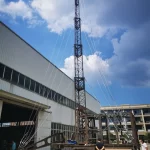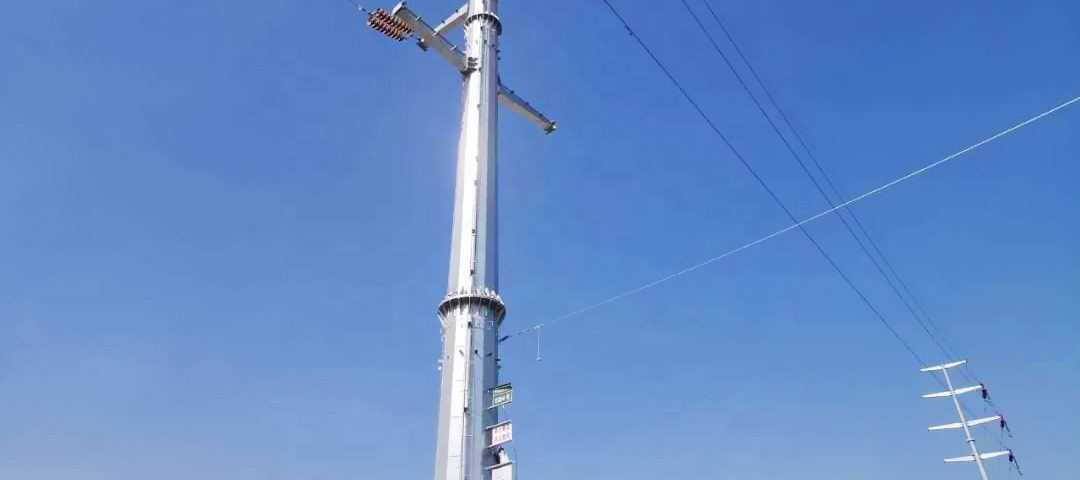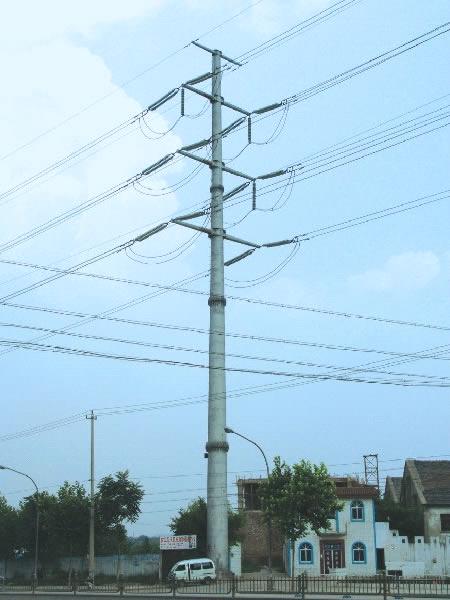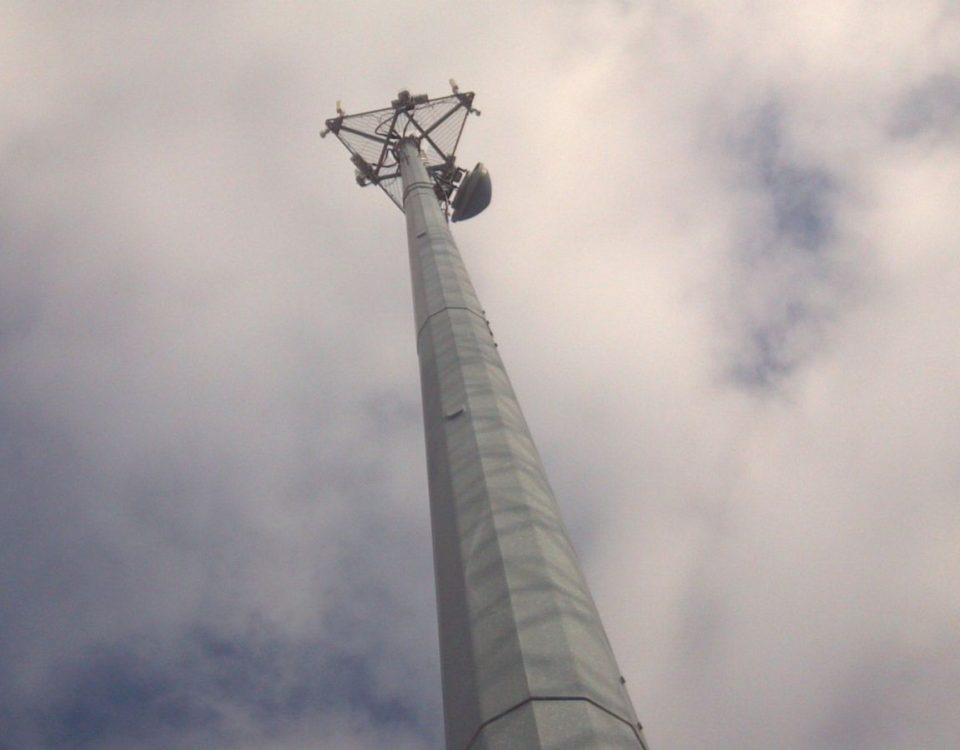
Self-Supporting Guyed Wire Steel Lattice Tower
December 13, 2024
Self-Guying Portable Mobile Antenna Steel Towers
December 18, 2024Galvanized Steel Monopole Towers for Transmission Lines
Galvanized Steel Monopole Towers for Transmission Lines: A Comprehensive Guide
Transmission lines are essential for delivering electricity over long distances, and the infrastructure supporting these lines is as important as the lines themselves. A key component of transmission line infrastructure is the Galvanized Steel Monopole Tower. These towers offer significant advantages in terms of stability, cost-efficiency, and durability, making them an ideal choice for modern electrical grids.
In this guide, we will explore the design, manufacturing, advantages, and applications of Galvanized Steel Monopole Towers, especially in the context of high-voltage transmission lines.
Table of Contents
| Topic | Subtopics |
|---|---|
| 1. Introduction to Galvanized Steel Monopole Towers | Definition and Overview |
| 2. Types of Transmission Line Towers | Lattice Towers vs. Monopole Towers |
| 3. Key Components of a Monopole Tower | Foundation, Pole, Crossarm, and Ancillary Parts |
| 4. Advantages of Galvanized Steel Monopole Towers | Durability, Aesthetics, Cost-Effectiveness, and Environmental Impact |
| 5. Galvanization Process | Steps in Hot-Dip Galvanization |
| 6. Design Considerations | Structural Load, Height, Spacing, and Safety |
| 7. Structural Engineering of Monopole Towers | Design Standards, Load Calculation, and Material Selection |
| 8. Manufacturing Process | Fabrication, Galvanization, and Assembly |
| 9. Applications of Galvanized Steel Monopole Towers | High-Voltage Power Lines, Communication Towers, and Rural Areas |
| 10. Installation Process | Site Preparation, Foundation Work, Assembly, and Testing |
| 11. Maintenance and Inspection | Regular Inspections, Corrosion Control, and Lifespan Extension |
| 12. Environmental Impact and Sustainability | Eco-friendly Design and Recycling Possibilities |
| 13. Cost Factors and Budgeting | Initial Costs, Operation, and Long-Term Savings |
| 14. Challenges in Installation and Operation | Site Accessibility, Weather Conditions, and Logistics |
| 15. Future Trends in Monopole Tower Technology | Smart Towers, Automation, and Innovations in Materials |
1. Introduction to Galvanized Steel Monopole Towers
A Galvanized Steel Monopole Tower is a single, tall vertical structure used primarily to support transmission lines. The term monopole refers to the fact that these towers are composed of a single pole, unlike lattice towers that have multiple supports. Steel monopoles are made from steel that has undergone the process of galvanization, which involves coating the steel with a layer of zinc to prevent corrosion and extend the tower’s lifespan.
2. Types of Transmission Line Towers
Lattice Towers vs. Monopole Towers
- Lattice Towers: These towers are composed of a framework of steel beams arranged in a lattice pattern. They are used in high-voltage transmission lines due to their strength but require more space and are less aesthetically pleasing.
- Monopole Towers: These towers are simpler and are made of a single vertical pole. They offer greater aesthetic appeal, take up less space, and are often used in urban areas or where minimal ground disturbance is required. Galvanized Steel Monopole Towers are increasingly popular due to their reduced material costs and superior corrosion resistance.
3. Key Components of a Monopole Tower
Foundation
The foundation of a monopole tower is essential to distribute the weight of the pole and ensure stability. The design varies based on soil conditions and the height of the tower.
Pole
The main body of the monopole is made of steel, typically tubular in shape. The steel’s galvanization protects it from rust and corrosion, particularly in harsh environments.
Crossarms
These are horizontal structures that hold the transmission lines. The design of crossarms depends on the type of lines being used and the desired height of the tower.
Ancillary Parts
Other components may include insulators, grounding systems, and safety equipment to ensure the tower can function effectively and safely.
4. Advantages of Galvanized Steel Monopole Towers
Durability
The galvanization process protects the steel from corrosion, allowing monopole towers to withstand harsh weather conditions and the effects of time.
Aesthetics
Unlike bulky lattice towers, monopoles offer a sleek, modern appearance that blends better with the surroundings, especially in urban environments.
Cost-Effectiveness
Although the initial cost of manufacturing and installing galvanized steel monopoles may be higher than traditional lattice towers, their reduced maintenance needs and longer lifespan lead to substantial cost savings over time.
Environmental Impact
The use of galvanized steel allows for greater recycling potential. Additionally, monopole towers take up less space and can be installed with less environmental disruption.
5. Galvanization Process
Galvanization is the process of applying a protective zinc coating to steel. This is achieved through hot-dip galvanization, where the steel is dipped into molten zinc to form a thick, durable coating that resists rusting.
Steps in Hot-Dip Galvanization
- Cleaning: The steel is cleaned to remove any dirt, grease, or rust.
- Pickling: The steel is immersed in a dilute acid solution to remove any remaining oxide layers.
- Fluxing: A flux solution is applied to the steel to help the zinc adhere.
- Dipping: The steel is dipped into molten zinc at temperatures around 450°C, where the coating is formed.
- Cooling: The galvanized steel is cooled, and the coating hardens.
This process ensures that the steel has a robust protective layer that significantly extends its operational life.
6. Design Considerations
When designing a Galvanized Steel Monopole Tower, several key factors must be considered:
- Structural Load: The tower must be designed to bear the weight of the transmission lines, wind load, and other environmental factors.
- Height: The height of the monopole affects both the design and the materials used.
- Spacing: Proper spacing between towers is crucial for the stability of the transmission lines.
- Safety: Ensuring the safety of both the installation crew and the environment is paramount.
7. Structural Engineering of Monopole Towers
Design Standards
Monopole towers are subject to strict design standards and codes, such as the IEEE 1313 for power transmission. These standards ensure that the towers can withstand environmental stressors like wind, ice, and seismic activity.
Load Calculation
Structural engineers calculate the loads based on factors such as wind speed, ice weight, and the number of cables to be supported.
Material Selection
The primary material used is high-strength steel, which provides the necessary strength while keeping weight manageable. Galvanized steel is preferred due to its longevity and resistance to corrosion.
8. Manufacturing Process
The manufacturing process of Galvanized Steel Monopole Towers includes the following stages:
- Design and Drafting: Detailed blueprints are created using computer-aided design (CAD) software.
- Fabrication: Steel is cut, welded, and shaped according to the specifications.
- Galvanization: As mentioned above, the steel components are dipped in molten zinc.
- Assembly: Once all parts are fabricated and galvanized, they are assembled into complete towers.
9. Applications of Galvanized Steel Monopole Towers
High-Voltage Power Lines
The most common use for monopole towers is in the transportation of high-voltage electricity across vast distances.
Communication Towers
Monopole towers are also used to support cellular and radio communication equipment.
Rural Areas
In rural or less populated areas, monopole towers provide an efficient solution due to their smaller footprint and reduced visual impact.
10. Installation Process
Site Preparation
Before installation, the site must be assessed for soil quality, environmental considerations, and accessibility.
Foundation Work
The foundation is prepared based on the local conditions, using materials such as concrete or reinforced steel.
Tower Assembly
The steel parts are transported to the site and assembled in stages.
Testing
After installation, thorough testing is conducted to ensure that the tower can safely bear the expected loads.
11. Maintenance and Inspection
Regular Inspections
Routine inspections are essential to monitor the condition of the tower, especially for signs of corrosion or damage.
Corrosion Control
Regular maintenance, such as touch-ups to the galvanization or applying anti-corrosion coatings, ensures long-term durability.
Lifespan Extension
By following best maintenance practices, the operational life of a monopole tower can be extended beyond the typical 40-50 years.
12. Environmental Impact and Sustainability
Monopole towers are designed with minimal environmental impact in mind. The galvanization process is relatively eco-friendly, and the towers themselves can be recycled at the end of their lifespan. Additionally, their smaller footprint means that less land is disturbed during installation.
16. Case Studies and Real-World Applications
Case Study 1: Monopole Towers in Rural Transmission Networks
In many rural or remote locations, traditional lattice towers might not be the most feasible due to the limited space, transportation issues, and the need to reduce environmental disruption. Monopole towers, with their streamlined design and smaller footprint, are increasingly being used in such areas. These towers offer a simple, fast installation process, minimizing disruption to the local ecosystem while providing reliable transmission of electricity. An example of this application can be seen in rural transmission projects in Africa, where monopole towers are commonly used to extend electrical grids to underserved areas.
Case Study 2: Urban Power Distribution
Monopole towers have also found success in urban settings where space is at a premium. One such project occurred in a high-density city in Europe, where the installation of monopole towers minimized the visual impact of the transmission lines. These towers were used in both underground and overhead transmission systems, providing a sleek solution to the urban challenge of limited space while maintaining the reliability of high-voltage transmission. The design of these towers took aesthetic considerations into account, blending well with the surrounding architecture.
Case Study 3: Monopole Towers for High-Voltage Overhead Transmission Lines in the U.S.
In the United States, monopole towers have been increasingly employed for high-voltage transmission lines due to their lower material cost, reduced ground disturbance, and ability to withstand various weather conditions. These towers have been deployed across vast distances, from rural to semi-urban locations, providing a more modern solution compared to conventional lattice towers. The longevity and low maintenance of galvanized steel monopole towers are particularly valued, as they offer reduced long-term costs for utilities.
17. Detailed Look at Monopole Tower Design Standards
Monopole towers are engineered to meet specific standards that ensure their safety, functionality, and long lifespan. These standards are governed by several international and national organizations, including the International Electrotechnical Commission (IEC), IEEE, and American National Standards Institute (ANSI). The key design standards for monopole towers are:
IEC Standards
- IEC 61400-1 (Wind turbine tower design): This standard provides guidelines for the design of towers used in wind energy applications but also has relevance for the structural integrity of monopole towers.
- IEC 62271-200 (High-voltage switchgear): Ensures that the monopole structures can safely bear the electrical equipment and withstand harsh conditions.
IEEE Standards
- IEEE 1313 (Design and construction of overhead transmission lines): This standard sets guidelines for the structural design of monopole towers used in power transmission.
Material Specifications
- ASTM A123/A123M: Specifies the coating process and minimum thickness for hot-dip galvanizing of steel used in monopole towers.
- ASTM A572: Defines the material strength requirements for steel structures, ensuring that the monopole tower can withstand tensile forces and harsh environmental conditions.
Load Testing and Safety Standards
Before any monopole tower is installed, rigorous load testing is done to ensure it meets the required standards for safety. This involves simulations to ensure the tower can withstand extreme weather events, including high winds, ice accumulation, and seismic movements.
18. Monopole Towers for Smart Grids: The Future of Transmission
As the demand for smart grids grows, the design and functionality of transmission towers are also evolving. Monopole towers are becoming more integrated into the digital infrastructure of smart grids. These advancements in technology are set to enhance the functionality of the towers:
Integrated Sensors for Monitoring
Smart monopole towers are equipped with sensors to monitor factors such as wind speed, temperature, and even the health of the structural materials. This data is sent in real-time to central control systems, allowing for predictive maintenance and quicker response to potential issues.
Load Balancing and Automation
Monopole towers are now being designed to communicate with grid management systems, which use real-time data to balance load and automatically redirect power in case of faults or outages. This will make transmission lines more resilient and responsive to fluctuating demands.
Energy Harvesting
There is also research into integrating energy harvesting technologies into monopole towers. These could include wind turbines or solar panels placed on the towers to generate small amounts of energy for operational systems such as sensors, lights, and communication devices.
19. Sustainability of Galvanized Steel Monopole Towers
In the context of sustainability, monopole towers provide a more eco-friendly alternative to traditional lattice towers. Here’s a breakdown of how these towers contribute to environmental sustainability:
1. Recyclability
Steel is one of the most recyclable materials globally, and monopole towers are predominantly made of steel. Once the tower reaches the end of its life, it can be disassembled, and its materials can be reused for new infrastructure projects. This significantly reduces the environmental impact compared to towers made from non-recyclable materials.
2. Reduced Material Use
Compared to lattice towers, monopole towers use less material to support the same load, which means fewer raw materials are consumed during the manufacturing process. Moreover, the material used is often stronger, which allows for fewer towers to be used in a given stretch of transmission line, further reducing resource consumption.
3. Lower Carbon Footprint
The galvanization process, while energy-intensive, leads to steel that lasts much longer without rusting or corroding. This long lifespan means that fewer replacements are needed, and therefore the overall carbon footprint of these towers over their lifetime is significantly lower than that of non-galvanized or wooden structures.
4. Efficient Installation Process
The monopole design simplifies the installation process. It requires less space and fewer foundation modifications compared to other types of towers. This reduces soil disturbance and lessens the ecological footprint during installation.
20. The Role of Monopole Towers in Renewable Energy Integration
With the growing focus on renewable energy sources such as wind and solar, monopole towers are also becoming increasingly important in supporting renewable energy infrastructure. Here’s how:
Support for Solar and Wind Power Transmission
In renewable energy projects, monopole towers are often used to carry transmission lines that transport electricity generated by wind farms or solar installations. The use of monopoles ensures that these high-voltage transmission lines can be installed in a cost-effective and space-efficient manner, especially in areas where renewable energy sources are located far from urban centers.
Flexibility and Adaptability
Monopole towers are adaptable to a wide range of environments, making them ideal for integration into various renewable energy systems. Their streamlined structure means they can be installed in areas where traditional lattice towers might not be practical, such as mountainous or forested regions.
Conclusion: The Future of Monopole Towers for Transmission Lines
The evolution of Galvanized Steel Monopole Towers represents a forward-thinking solution for the modern electrical grid. With their combination of strength, durability, and aesthetic appeal, monopoles are increasingly becoming the preferred choice for high-voltage transmission lines in both urban and rural areas. Their minimal environmental impact, long lifespan, and cost-effectiveness make them a key player in shaping the future of energy infrastructure.
As the demand for more sustainable and efficient transmission systems grows, monopole towers are well-positioned to meet the needs of modern power grids, particularly with advancements in smart grid technology, renewable energy integration, and environmental sustainability.
Frequently Asked Questions (Continued)
7. How does the use of monopole towers reduce environmental impact? Monopole towers are more space-efficient and cause less environmental disruption during installation. They also use fewer materials and are fully recyclable at the end of their lifespan.
8. Are there any smart technologies integrated into monopole towers? Yes, some monopole towers are now equipped with sensors that monitor structural health, wind speed, temperature, and other factors, allowing for predictive maintenance and efficient grid management.
9. How do monopole towers contribute to renewable energy integration? Monopole towers support the transmission of electricity from renewable sources like wind and solar farms, ensuring that clean energy can be delivered efficiently to where it’s needed.
10. Can monopole towers be used in all geographical conditions? Yes, monopole towers are versatile and can be installed in a wide range of geographical conditions, including urban areas, forests, mountains, and rural locations.
11. What is the expected lifespan of a galvanized steel monopole tower? The expected lifespan of a galvanized steel monopole tower is 40-50 years, with proper maintenance and regular inspections.
12. How do monopole towers compare to lattice towers in terms of maintenance? Monopole towers require less maintenance due to their simplified design and corrosion-resistant galvanized steel coating, reducing long-term costs.










